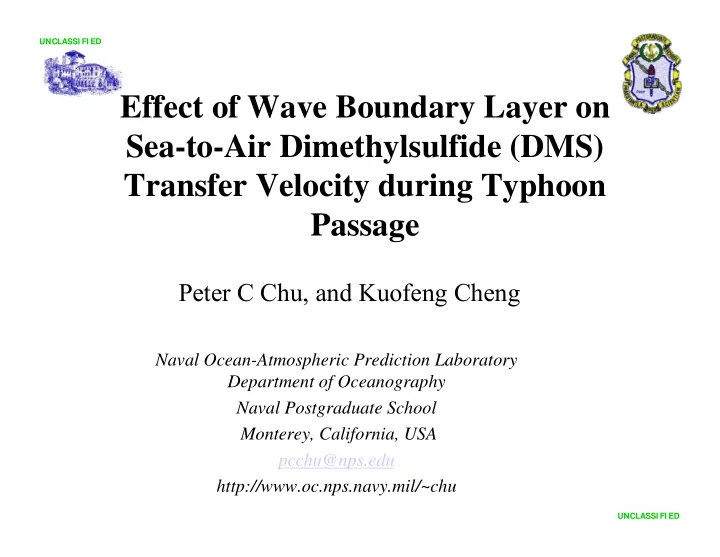

UNCLASSI FI ED Effect of Wave Boundary Layer on Sea-to-Air Dimethylsulfide (DMS) Transfer Velocity during Typhoon Passage Peter C Chu, and Kuofeng Cheng Naval Ocean-Atmospheric Prediction Laboratory Department of Oceanography Naval Postgraduate School Monterey, California, USA pcchu@nps.edu http://www.oc.nps.navy.mil/~chu UNCLASSI FI ED
UNCLASSI FI ED References • Chu, P.C., and K.F. Cheng, 2006: Effect of wave boundary layer on the sea-to-air dimethylsulfide transfer velocity during typhoon passage. Journal of Marine Systems, in press. UNCLASSI FI ED
UNCLASSI FI ED The dominant natural source of sulfur to the atmosphere is the oceanic DMS (Bates et al., 1992; Gondwe et al., 2003). DMS changes the radiation budget in the atmosphere and in turn changes the climate. UNCLASSI FI ED
UNCLASSI FI ED Flux Parameterization Issues (Fairall el al. 2005) • Representation in GCM • Most observations are point time averages • Concept of gustiness sufficient? • Mesoscale variable? Precip, convective mass flux, … • Strong winds • General question of turbulent fluxes, flow separation, wave momentum input • Sea spray influence • Waves • Stress vector vs wind vector (2-D wave spectrum) • z o vs wave age & wave height • Breaking waves • Gas and particle fluxes • Distribution of stress and TKE in ocean mixed layer • Gas fluxes • Bubbles • Surfactants (physical vs chemical effects) • Extend models to chemical reactions UNCLASSI FI ED
UNCLASSI FI ED What is the effect of the wave boundary layer (WBL) on the sea-to-air DMS transfer? UNCLASSI FI ED
UNCLASSI FI ED Waves UNCLASSI FI ED
UNCLASSI FI ED Drag Coefficient and Roughness Length z r = 10 m Nondimensional Roughness Length UNCLASSI FI ED
UNCLASSI FI ED Effect of WBL on Momentum Transfer • With WBL: Chalikov (1995) • Without WBL: Charnock parameterization (1955) parameter C p is the peak phase speed. UNCLASSI FI ED
UNCLASSI FI ED WBL Effects • Waves → z 0 → C D → k a • Waves → z 0 → (Re, Sc) → k w • WaveWatch-3 for the South China Sea as an example UNCLASSI FI ED
UNCLASSI FI ED NOAA WaveWatch-3 Third Generation Wave Model (Tolman 1999) ∂ ∂ ∂ ∂ ∂ 1 N S � cos � � � + φ θ + λ + + θ = N N k N N ∂ φ ∂ φ ∂ λ ∂ ∂ θ σ g cos t k , = + + + S S S S S in nl ds bot , θ + θ + sin cos c g U c g U � � φ φ λ = φ = φ cos R R φ θ tan cos c g � = � θ θ − g R UNCLASSI FI ED
UNCLASSI FI ED WaveWatch-3 was evaluated using T/P (a) crossover points and (b) tracks in the SCS (Chu et al., 2003, JTECH) UNCLASSI FI ED
UNCLASSI FI ED South China Sea UNCLASSI FI ED
UNCLASSI FI ED Typhoon 23W (Wukong) Sept 5-11, 2000 Maximum Sustained Wind: 38 m/s UNCLASSI FI ED
UNCLASSI FI ED Effect of WBL on z 0* Nondimensional Peak Wave Frequency UNCLASSI FI ED
UNCLASSI FI ED Effect of WBL on C D UNCLASSI FI ED
UNCLASSI FI ED Relative Difference of C D UNCLASSI FI ED
UNCLASSI FI ED Sea-to-Air DMS Flux (McGillis et al., 2000) • Air transfer velocity k a • Water transfer velocity k w • DMS concentrations at airside ( C a ) • DMS concentrations at waterside ( C w ) UNCLASSI FI ED
UNCLASSI FI ED Waterside DMS Transfer Velocity (Jahne et al., 1987; McGillis et al., 2000) • Waterside transfer velocity ( n = 0.58) • Schmidt Number = 720 (DMS at 300 K) • DMS Diffusion coefficient (Saltzman et al., 1993) Roughness Reynolds Number UNCLASSI FI ED
UNCLASSI FI ED WBL Effects • Waves → z 0 → C D → k a • Waves → z 0 → (Re, Sc) → k w • WaveWatch-3 for the South China Sea as an example UNCLASSI FI ED
UNCLASSI FI ED Effect of WBL on k w UNCLASSI FI ED
UNCLASSI FI ED Relative Difference of k w UNCLASSI FI ED
UNCLASSI FI ED Conclusions • (1) WBL increases C D and in turn enhances the momentum flux. • (2) WBL decreases k w and in turn weakens the sea-to-air DMS transfer. • (3) Such opposite WBL effects are evident for minor typhoon (Wukong, max wind ~ 38 m/s) • (4) Such opposite WBL effects on the climate should be further investigated. UNCLASSI FI ED
Recommend
More recommend